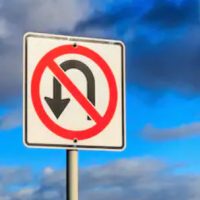What to Know About U-Turn Accidents

Statistics show that approximately one-quarter of car accidents happen at intersections. Intersection accidents can be caused by various factors, but one common one is U-turns. A U-turn is a 180-degree rotation in which a vehicle turns in a U-shaped course so as to face in the opposite direction.
U-turns are a quick way to turn around, but they can be dangerous maneuvers. If other drivers are not seeing you make a U-turn, you could cause a serious or even fatal accident. Sometimes U-turns are legal at green lights when you are in a turn lane. In some cases, though, they are illegal. There will be signs instructing you not to make such a turn.
This is what makes U-turn accidents complex. When one happens, the insurance company will need to know who is at fault. Is the driver who made the U-turn at fault? Or is it the other party for not seeing the vehicle making the U-turn?
Causes of U-Turn Accidents
U-turn accidents may be caused by the following:
- Lack of visibility. Drivers may not have a clear view of oncoming traffic or other vehicles when making a U-turn, leading to collisions.
- Physical obstructions, such as parked cars, buildings, or trees, can block a driver’s view, making U-turns more dangerous.
- Failure to yield. Not yielding to oncoming traffic or pedestrians can result in accidents. Drivers sometimes underestimate the speed of oncoming vehicles or don’t see them in time.
- Improper judgment. Misjudging the speed and distance of oncoming vehicles is a frequent cause of U-turn accidents.
- Illegal U-turns. Making U-turns in prohibited areas, such as at intersections with “No U-turn” signs, can lead to collisions.
- Distracted driving. Drivers not paying full attention to the road while making a U-turn are more likely to cause an accident.
- High speeds reduce the time available to react to vehicles making U-turns, increasing the likelihood of an accident.
- Poor road conditions. Wet, icy, or otherwise compromised road surfaces can cause vehicles to skid or lose control during a U-turn.
- Aggressive driving. Drivers who make sudden or aggressive U-turns can catch other drivers off guard, leading to accidents.
Who is at Fault?
The driver making the U-turn is typically liable for a U-turn accident, but this may depend on the signage. U-turn signs are placed:
- At intersections. The sign clarifies whether making U-turns is allowed on the connected roads.
- Near schools and in residential areas. This is done to help manage traffic flow and ensure safety.
- Highways and divided roads. Signs will indicate designated turn-around points.
There are two main types of signage:
- Permitted U-turn sign. These signs indicate that making U-turns in specific locations is allowed and safe.
- Prohibited U-turn sign. This sign will have a red slash through it depicting that making a U-turn is not allowed.
These designations can help establish who made an illegal U-turn.
Contact a Personal Injury Lawyer
Maneuvers such as U-turns can be dangerous, causing serious accidents.
Involved in a U-turn accident? A Houston U-turn accident attorney from The West Law Office, PLLC can assist you. You deserve an aggressive advocate looking out for your rights and best interests. To schedule a consultation with our office, call 281-347-3247 or fill out the online form.
Source:
reveriepage.com/blog/who-is-at-fault-for-a-u-turn-accident

